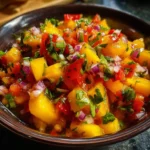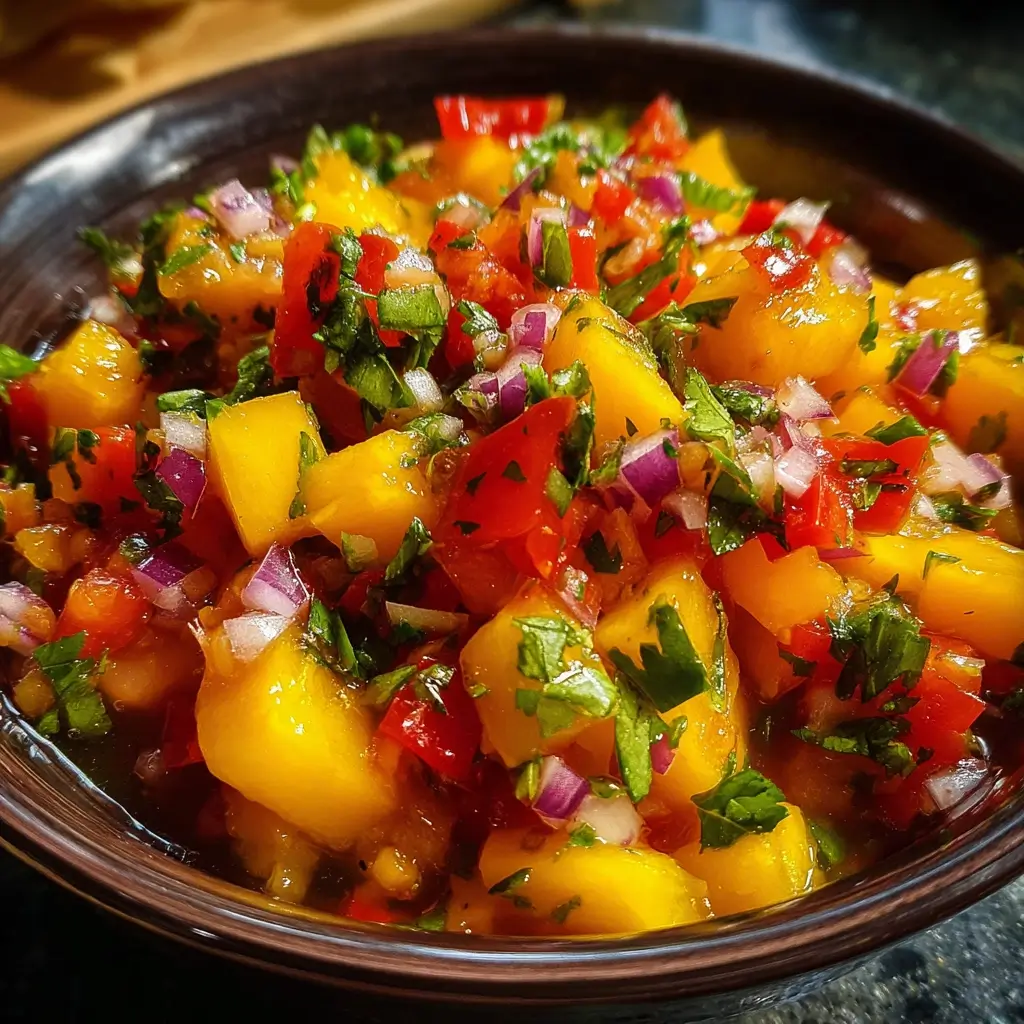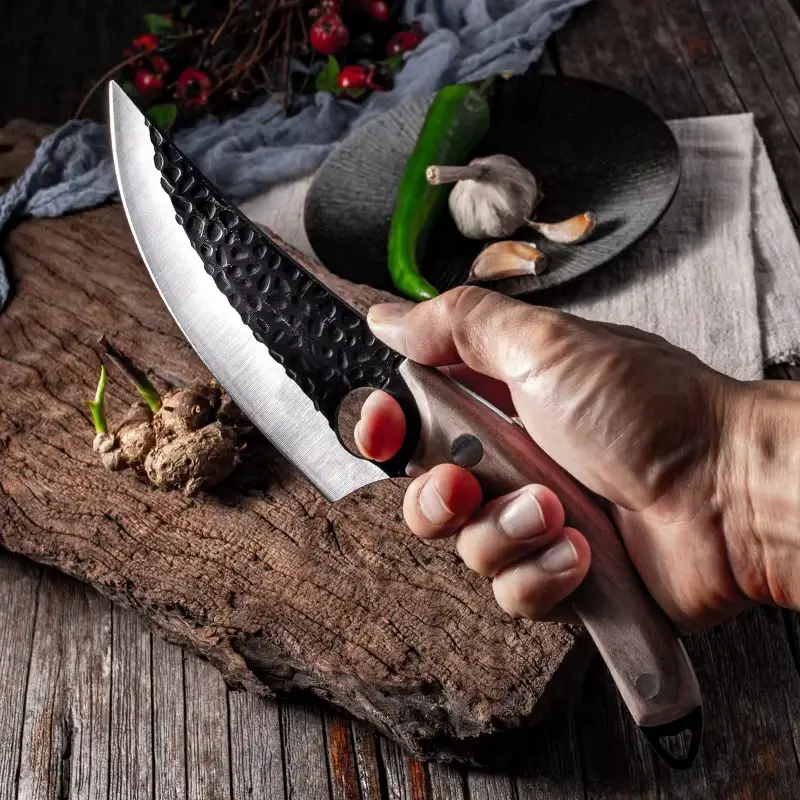Of all the recipes that have graced my kitchen table over the years, there are a select few that become instant legends. They are the dishes requested for every family gathering, the ones my friends beg for the recipe to, and the flavors that define a season. This Spicy Mango Salsa is, without a doubt, the undisputed champion of summer in my household. I first whipped it up on a whim for a backyard barbecue, hoping to add a splash of color and zest to the spread of grilled chicken and beef. I wasn’t prepared for the reaction. The bowl was scraped clean within twenty minutes, with guests foregoing traditional sauces and toppings entirely, opting instead to pile this vibrant, jewel-toned salsa onto everything. The magic is in the balance: the sun-ripened sweetness of the mango, the sharp bite of red onion, the fresh, herbaceous notes of cilantro, the subtle crunch of bell pepper, and that delightful, creeping warmth from the jalapeño that makes you reach for another chip. It’s a symphony of textures and flavors that is simultaneously refreshing and exciting. This isn’t just a recipe; it’s a celebration in a bowl, a guaranteed crowd-pleaser that transforms any simple meal into a tropical feast.
Ingredients
- 3 large, ripe mangoes, diced (about 4 cups): The star of the show. Choose mangoes that are slightly soft to the touch with a sweet, fragrant aroma at the stem. Ataulfo or Honey mangoes are fantastic for their creamy texture and minimal fibers, but any ripe mango will work beautifully.
- 1 medium red onion, finely diced (about 1 cup): Provides a sharp, pungent counterpoint to the sweet mango. Red onions offer a milder flavor and a stunning purple hue that adds to the salsa’s visual appeal.
- 1 red bell pepper, finely diced (about 1 cup): This adds a wonderful, sweet crunch and another layer of vibrant color. It complements the mango’s softness with its firm texture.
- 1-2 jalapeños, finely minced: The source of our signature spice. For a milder salsa, carefully remove all seeds and the white pith before mincing. For a fiery kick, leave some or all of them in.
- 1 large bunch of fresh cilantro, chopped (about 1 cup, loosely packed): Lends a fresh, citrusy, and slightly peppery flavor that is essential in any good salsa. If you’re not a fan, you can substitute with fresh parsley, though the flavor profile will change.
- Juice of 2 large limes (about 1/4 cup): This is non-negotiable. The bright acidity of fresh lime juice cuts through the sweetness of the mango, brightens all the other flavors, and helps to preserve the salsa.
- 1/2 teaspoon fine sea salt: Crucial for bringing all the flavors together. Salt enhances the sweetness of the mango and tames the raw bite of the onion, creating a more harmonious blend.
Instructions
- Prepare the Mango: The trickiest part for many is dicing the mango. Start by holding the mango upright on a cutting board. The large, flat pit runs through the center. Slice downwards on either side of the pit, cutting off the two fleshy “cheeks.” Take one cheek and score the flesh in a grid pattern, being careful not to cut through the skin. Then, use a large spoon to scoop the diced flesh away from the skin and into a large mixing bowl. Alternatively, you can invert the scored cheek so the cubes pop outwards (the “hedgehog” method) and slice them off. Carefully trim and dice the remaining flesh from around the pit and add it to the bowl.
- Dice the Vegetables: Finely dice the red onion and the red bell pepper. The key to a great salsa texture is uniformity. Aim for a dice that is similar in size to your mango cubes. This ensures you get a little bit of everything in each bite. Add the diced onion and bell pepper to the bowl with the mango.
- Mince the Jalapeño: When handling jalapeños, it’s wise to wear gloves to avoid getting the spicy oils (capsaicin) on your skin. Slice the jalapeño in half lengthwise. For less heat, use a spoon to scrape out the seeds and the white membrane, as this is where most of the heat is concentrated. Finely mince the green flesh and add it to the bowl. Start with one jalapeño; you can always add more later if you desire more spice.
- Chop the Herbs and Add Acidity: Roughly chop your fresh cilantro and add it to the mixture. Squeeze the fresh lime juice directly over the ingredients in the bowl. The lime juice will not only add flavor but will also help prevent the mango from browning too quickly.
- Combine and Season: Using a large spoon or spatula, gently fold all the ingredients together. Be careful not to mash or over-mix; you want to maintain the distinct chunks of mango and vegetables. Sprinkle the sea salt over the salsa and give it one final, gentle stir to incorporate.
- Let the Flavors Meld: This is a crucial, often-skipped step. Cover the bowl and let the salsa rest in the refrigerator for at least 30 minutes, or up to 2 hours, before serving. This “melding” time allows the salt to draw out some of the juices, the lime to marinate the onion, and for all the individual components to marry into one cohesive, spectacular flavor.
- Taste and Adjust: Before serving, give the salsa a final taste. Does it need more salt to make the flavors pop? A little more lime juice for brightness? More minced jalapeño for heat? Adjust accordingly to suit your personal preference.
Nutrition Facts
- Servings: This recipe yields approximately 6 cups of salsa, serving about 12 people (as a 1/2 cup serving).
- Calories per serving: Approximately 85 kcal.
- Vitamin C: An absolute powerhouse of Vitamin C, thanks to the mangoes, bell pepper, and lime juice. This vitamin is a powerful antioxidant and crucial for immune system support.
- Fiber: A good source of dietary fiber from the mangoes and vegetables, which aids in digestion and helps you feel full and satisfied.
- Healthy Fats: While very low in fat overall, this salsa is a fantastic partner for foods rich in healthy fats, like avocado or grilled salmon.
- Low in Sodium: By making it at home, you have complete control over the sodium content, making it a much healthier alternative to many store-bought salsas and dips.
Preparation Time
The total preparation time for this Spicy Mango Salsa is approximately 45 minutes. This can be broken down as follows:
- Active Chopping and Mixing Time: 20-25 minutes. This depends largely on your knife skills and speed in dicing the mangoes, onions, and peppers.
- Flavor Melding Time (Resting): A minimum of 30 minutes is highly recommended. This passive time is essential for the flavors to develop fully, so don’t be tempted to skip it!
How to Serve
This salsa’s versatility is one of its greatest strengths. It can elevate a wide variety of dishes or stand proudly on its own. Here are some of our favorite ways to serve it:
- The Classic Dip:
- Serve in a vibrant bowl alongside a platter of sturdy, salted tortilla chips.
- For a healthier option, pair it with crunchy jicama sticks, cucumber slices, or mini bell peppers for dipping.
- The Perfect Topping for Proteins:
- Grilled Fish: Spoon generously over a perfectly grilled piece of mahi-mahi, cod, or salmon. The sweet and spicy notes cut through the richness of the fish beautifully.
- Fish Tacos: It is an absolute must for fish or shrimp tacos. Pile it onto warm tortillas with your favorite grilled seafood, some shredded cabbage, and a drizzle of chipotle crema.
- Grilled Chicken: Transform a simple grilled chicken breast from bland to brilliant. The juicy salsa acts as both a sauce and a side dish.
- Seared Scallops: The elegance of seared scallops is wonderfully complemented by the tropical flair of this salsa.
- A Vibrant Addition to Bowls and Salads:
- Spoon it over a burrito bowl with black beans, brown rice, corn, and avocado for a burst of fresh flavor.
- Use it as a dressing for a simple green salad. The juices from the salsa are often enough to dress the leaves, especially when paired with grilled chicken or shrimp.
- Creative and Unexpected Pairings:
- Quesadillas: Serve it on the side of a cheesy chicken or black bean quesadilla for dipping.
- On a Cheese Board: Add a small bowl to a cheese board. It pairs surprisingly well with creamy cheeses like goat cheese or a sharp white cheddar.
- With Beef: While often paired with lighter proteins, a spoonful on top of a grilled steak or inside a beef taco adds an unexpected and delicious sweet and spicy contrast.
Additional Tips
- Choosing the Perfect Mango is Key: The quality of your salsa lives and dies by the quality of your mango. Look for one that gives slightly when gently pressed, similar to a ripe avocado or peach. It should also have a sweet, fruity fragrance at the stem. Avoid mangoes that are overly mushy, have black spots, or smell sour.
- Master the Spice Level: The heat in this salsa is entirely customizable. For a very mild version, use only half a jalapeño and be meticulous about removing every seed and all of the white pith. For a salsa that will make you sweat, try a serrano pepper, or for the truly brave, a finely minced habanero (use with extreme caution!).
- The Magic of Melding: We mentioned it in the instructions, but it bears repeating. Letting the salsa rest is not just a suggestion; it’s a critical step. During this time, osmosis works its magic. The salt draws moisture from the mango and onion, creating a natural, flavorful juice, while the acid from the lime “cooks” the raw onion, mellowing its harsh bite.
- Uniformity Matters: Try to dice your mango, red onion, and bell pepper to a relatively uniform size. This isn’t just for aesthetics; it ensures a balanced flavor and texture in every single spoonful. A bite with a giant chunk of onion and no mango is not nearly as pleasant.
- Get Creative with Add-Ins: This recipe is a fantastic base for experimentation. Feel free to add a cup of cooked black beans or corn for more substance. A diced avocado added just before serving lends a wonderful creaminess. For a different texture and flavor, try adding diced cucumber or jicama.
- Don’t Be Shy with the Salt: Salt does more than just make things “salty.” In this recipe, it’s a flavor enhancer. It amplifies the sweetness of the mango and the tartness of the lime. If your finished salsa tastes a little flat, the first thing you should add is another small pinch of salt.
- Fresh Lime Juice is Non-Negotiable: The bottled, concentrated lime juice from the store simply cannot compare to the flavor of a freshly squeezed lime. It often has a muted or slightly chemical aftertaste. The bright, zesty punch of fresh lime is essential to make this salsa truly shine. For an extra pop, add a little lime zest as well.
- Make-Ahead Strategy: You can absolutely make this salsa ahead of time, which makes it perfect for parties. It’s often even better on the second day as the flavors continue to meld. However, it’s best consumed within 2-3 days. After that, the mango can become overly soft and the salsa can become watery. If adding avocado, always do so just before serving to prevent it from browning.
FAQ Section
1. How do I know if my mango is ripe enough for salsa?
A ripe mango will have a little “give” when you gently squeeze it. It shouldn’t be rock hard or mushy. The most reliable indicator is smell; a ripe mango will have a distinctly sweet and fruity aroma near the stem end. Color is not always the best indicator, as different varieties have different colors when ripe.
2. Can I use frozen mango for this recipe?
Yes, you can use frozen mango in a pinch, and it’s a great option when mangoes aren’t in season. Thaw the frozen mango chunks completely and drain any excess liquid before dicing them further and adding them to the salsa. The texture will be slightly softer than with fresh mango, but the flavor will still be delicious.
3. My salsa seems too watery. How can I fix it?
This can sometimes happen, especially if the mangoes are extra juicy. The best way to fix it is to use a slotted spoon to serve the salsa, leaving the excess liquid behind in the bowl. You can also try to drain the salsa in a fine-mesh sieve for a few minutes before transferring it to your final serving bowl.
4. How long will this spicy mango salsa last in the refrigerator?
When stored in an airtight container in the refrigerator, the salsa will stay fresh for up to 3 days. The lime juice acts as a natural preservative. Keep in mind that the texture will soften over time as the ingredients release their juices. It’s at its absolute best in the first 48 hours.
5. How can I make the salsa more or less spicy?
To make it less spicy, be sure to remove all the seeds and the white, rib-like membranes from the inside of the jalapeño, as that’s where most of the capsaicin (the heat compound) is stored. You can also use less jalapeño or substitute it with a milder pepper like an anaheim. To make it spicier, leave the seeds in, add an extra jalapeño, or upgrade to a more potent pepper like a serrano or habanero.
6. I don’t like cilantro. What can I use as a substitute?
Cilantro has a very distinct flavor that some people are genetically predisposed to dislike (the “soapy” gene). If you’re one of them, you can substitute it with fresh flat-leaf parsley. It will provide that fresh, green, herbaceous note, though the overall flavor profile will be different. Some people also enjoy a small amount of fresh mint for a different kind of tropical twist.
7. Can I freeze mango salsa?
Unfortunately, freezing is not recommended for this type of fresh salsa. The freezing and thawing process would completely break down the cellular structure of the mango, onion, and bell pepper, resulting in a mushy, watery, and unappetizing texture. This recipe is best enjoyed fresh.
8. What other fruits can I use in this salsa instead of mango?
This salsa recipe is very adaptable to other fruits! For a similar tropical vibe, you could use fresh pineapple. Peaches or nectarines work beautifully in the summer for a more temperate take. You could even try a mix of fruits, like mango and pineapple, or peach and strawberry, for a complex and delicious fruit salsa. Just be sure to pair the sweetness of the fruit with the same spicy and acidic elements.

Spicy Mango Salsa Recipe
Ingredients
- 3 large, ripe mangoes, diced (about 4 cups): The star of the show. Choose mangoes that are slightly soft to the touch with a sweet, fragrant aroma at the stem. Ataulfo or Honey mangoes are fantastic for their creamy texture and minimal fibers, but any ripe mango will work beautifully.
- 1 medium red onion, finely diced (about 1 cup): Provides a sharp, pungent counterpoint to the sweet mango. Red onions offer a milder flavor and a stunning purple hue that adds to the salsa’s visual appeal.
- 1 red bell pepper, finely diced (about 1 cup): This adds a wonderful, sweet crunch and another layer of vibrant color. It complements the mango’s softness with its firm texture.
- 1–2 jalapeños, finely minced: The source of our signature spice. For a milder salsa, carefully remove all seeds and the white pith before mincing. For a fiery kick, leave some or all of them in.
- 1 large bunch of fresh cilantro, chopped (about 1 cup, loosely packed): Lends a fresh, citrusy, and slightly peppery flavor that is essential in any good salsa. If you’re not a fan, you can substitute with fresh parsley, though the flavor profile will change.
- Juice of 2 large limes (about 1/4 cup): This is non-negotiable. The bright acidity of fresh lime juice cuts through the sweetness of the mango, brightens all the other flavors, and helps to preserve the salsa.
- 1/2 teaspoon fine sea salt: Crucial for bringing all the flavors together. Salt enhances the sweetness of the mango and tames the raw bite of the onion, creating a more harmonious blend.
Instructions
- Prepare the Mango: The trickiest part for many is dicing the mango. Start by holding the mango upright on a cutting board. The large, flat pit runs through the center. Slice downwards on either side of the pit, cutting off the two fleshy “cheeks.” Take one cheek and score the flesh in a grid pattern, being careful not to cut through the skin. Then, use a large spoon to scoop the diced flesh away from the skin and into a large mixing bowl. Alternatively, you can invert the scored cheek so the cubes pop outwards (the “hedgehog” method) and slice them off. Carefully trim and dice the remaining flesh from around the pit and add it to the bowl.
- Dice the Vegetables: Finely dice the red onion and the red bell pepper. The key to a great salsa texture is uniformity. Aim for a dice that is similar in size to your mango cubes. This ensures you get a little bit of everything in each bite. Add the diced onion and bell pepper to the bowl with the mango.
- Mince the Jalapeño: When handling jalapeños, it’s wise to wear gloves to avoid getting the spicy oils (capsaicin) on your skin. Slice the jalapeño in half lengthwise. For less heat, use a spoon to scrape out the seeds and the white membrane, as this is where most of the heat is concentrated. Finely mince the green flesh and add it to the bowl. Start with one jalapeño; you can always add more later if you desire more spice.
- Chop the Herbs and Add Acidity: Roughly chop your fresh cilantro and add it to the mixture. Squeeze the fresh lime juice directly over the ingredients in the bowl. The lime juice will not only add flavor but will also help prevent the mango from browning too quickly.
- Combine and Season: Using a large spoon or spatula, gently fold all the ingredients together. Be careful not to mash or over-mix; you want to maintain the distinct chunks of mango and vegetables. Sprinkle the sea salt over the salsa and give it one final, gentle stir to incorporate.
- Let the Flavors Meld: This is a crucial, often-skipped step. Cover the bowl and let the salsa rest in the refrigerator for at least 30 minutes, or up to 2 hours, before serving. This “melding” time allows the salt to draw out some of the juices, the lime to marinate the onion, and for all the individual components to marry into one cohesive, spectacular flavor.
- Taste and Adjust: Before serving, give the salsa a final taste. Does it need more salt to make the flavors pop? A little more lime juice for brightness? More minced jalapeño for heat? Adjust accordingly to suit your personal preference.
Nutrition
- Serving Size: one normal portion
- Calories: 85






